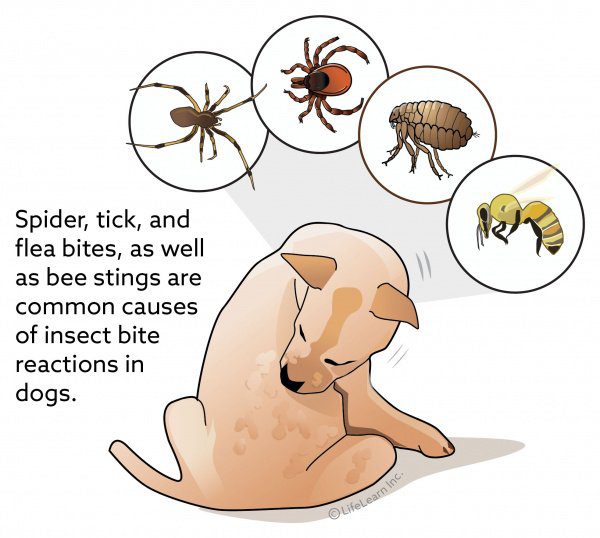
The dog was bitten by an insect. What to do?
Technically, these insects do not bite, but sting – they pierce the victim’s skin with a sting and release poison into the wound. Bees and wasps have stingers, venom glands, and a reservoir for the venom in the back of the abdomen.
Most often, bee and wasp stings are noted in the area of uXNUMXbuXNUMXbthe muzzle and head. But often the front paws suffer, as well as the oral cavity, as dogs have a habit of catching flying insects with their mouths and exploring the world around them with the help of smell.
Symptoms
When bitten by a stinging insect, the dog suddenly begins to feel anxious, rub its muzzle with its paws, or intensively lick the bitten place. Soon, swelling, redness, and severe pain may appear at the site of the bite. Sometimes, after a bee or wasp sting, an affected dog may develop an allergic reaction and even go into anaphylactic shock.
bee sting
The bee stinger has notches, so when piercing the skin of a warm-blooded animal, it gets stuck and breaks out of the bee’s body along with the poison reservoir and poisonous glands. Therefore, a bee can only sting once.
After a bee attack, it is very important to inspect the pet as soon as possible and remove the remaining sting, as the release of poison continues for some time. When removing the sting, it is best to use a plastic card (for example, a bank card), it should be leaned against the skin and moved along with the sting towards the stinging apparatus, this will prevent the remaining poison from being squeezed out of the glands into the wound. That is why you should not pull out the sting with your fingers or tweezers.
Stings of wasps, hornets and bumblebees
These insects are able to sting repeatedly, as their sting is smooth. Bumblebees are usually quite peaceful and attack only when defending nests. Wasps and hornets, on the contrary, are characterized by increased aggressiveness.
First aid
A single bee or wasp sting usually does not pose a danger to a dog. Although, of course, this is very unpleasant and can be especially painful in case of a bite in the area of uXNUMXbuXNUMXbthe muzzle and nose. In such cases, ice should be applied for a short time, this will reduce swelling and pain. It is important to monitor the condition of the dog after the bite of a stinging insect in order to have time to see a doctor in time in case of an allergic reaction or anaphylactic shock. A large number of bites, especially in the head, neck, or mouth, can lead to severe swelling and airway obstruction.
Anaphylactic shock
Anaphylactic shock is a life-threatening, critical condition that affects vital organ systems: respiratory, cardiovascular, digestive, and skin.
Symptoms of anaphylactic shock include many signs from different body systems. So, on the skin, it is manifested by itching, swelling, the appearance of blisters, hives, rashes, redness. In the case of a very severe allergic reaction, skin symptoms may not have time to fully manifest.
In anaphylactic shock, the symptoms also affect the respiratory system: the dog begins to cough, breathing quickens, becomes difficult and “whistling”. On the part of the digestive system, nausea, vomiting, diarrhea (with or without blood) can be observed, and on the part of the cardiovascular system, a sharp drop in blood pressure, loss of consciousness. If these symptoms appear, you should urgently take the dog to the nearest clinic.
If it is already known that the dog is allergic to stinging insect bites, then it is worth taking precautions when walking in the forest and parks, or generally avoiding places where the dog can meet a nest of bees or wasps. Keep a close eye on your dog and carry a first aid kit with you. What kind of drugs should be included in the first aid kit and how to use them, the attending veterinarian of the dog will tell. In case of emergencies, it will be useful to have the contacts of the nearest round-the-clock clinics and the attending physician on your phone.





